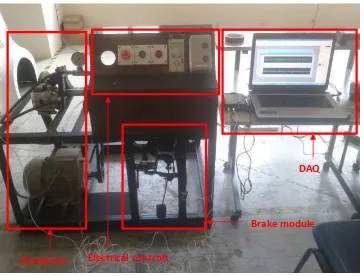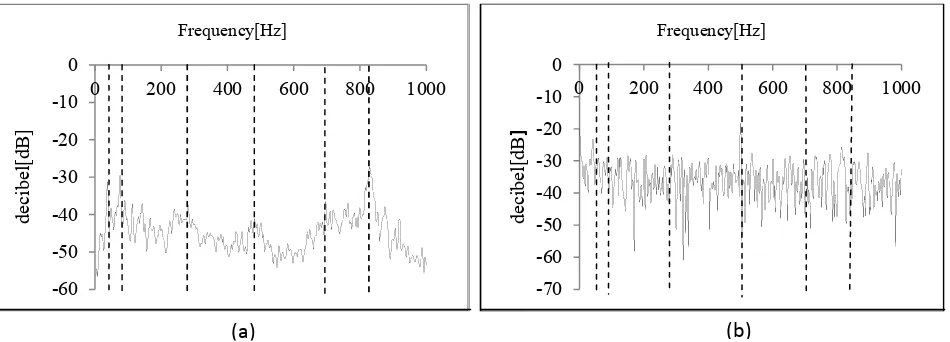A Parallel Study of Vibration Analysis and Acoustic Analysis In Low
Frequency Brake Noise
Magaswaran, K.
a*, Hassan, M.Z.
band Phuman Singh, A.S.
cDepartment of Automotive, Faculty of Mechanical Engineering,
Universiti Teknikal Malaysia Melaka, Durian Tunggal, 76100 Melaka, Malaysia
a[email protected], b[email protected], c[email protected]
Keywords: brake noise, vibration analysis, acoustic analysis
Abstract. An acoustic analysis in the investigation of brake noise shows the severity of the noise and its characteristics and a vibration analysis shows the excitations of noise that is present in the braking event. In this study, vibration and acoustic analyses were used to study the brake noise which is produced during braking. Vibration and acoustic data were collected simultaneously during braking to identify the braking condition. The data analysis focuses on the low frequency domain. The Fast Fourier method was used to analyse the vibration and acoustic signals. The computation of FFT was done independently and the frequency domains obtained were compared. The parallelism in the analysis was used to identify the acoustic source. The determination of the source will aid in brake noise reduction efforts and reinforce the vibration analysis method as a system identification method for brake noise.
Introduction
The current subject of brake noise falls under the wide field of noise, vibration and harshness (NVH). As the noise level from the vehicles drivetrain has been lower than the past, the brake noise that was masked by these noises has risen to attention as a problem. The brake noise can be divided into the low frequency domain and the high frequency domain [1]. Whether it is sensible or audible, the brake NVH issue leads to almost to a billion dollar in warranty claims in the United States each year [2]. The general or the initial mechanism of the brake noise is friction induced vibration. Friction is the basic operation of a brake system thus friction becomes the primary excitation of noise during braking. Regardless of the nature of the noise, friction variations coupled with dynamic instabilities are the factors which induce brake noise. [3] The pad and disc pair can undergo various situations or conditions such as thermal deformation, disc thickness variation (DTV), brake torque variation (BTV) and brake pressure variation (BPV) [4,5,6]. Nonetheless, all these are accepted as factors involved in brake noise generation but the fact is that all these factors influence on friction is overlooked. Mechanisms of noise generation based on friction are stick and slip, negative damping and mode couplings [7,8,9]. Each study is done through experimentations and modelling solely focusing on each individual mechanism, but in an event of braking, various excitations and mechanisms happen simultaneously. The possibility of interdependency of each mechanism is rare in the literature. Thus, in this study a measurement of brake noise and vibration that happens in the low frequency was done to show its occurrence in a single braking event. The characteristics of noise and vibration that is recorded will be the system identification of the brake system. System identification is the initial step in identifying the system behaviour as a whole before an improvement can be made.
Experimentation
An in house developed brake dynamometer was used to conduct the experiment. The brake dynamometer was setup as such to record the vibration of the brake pad by placing accelerometers on the brake pad. The brake pad is the primary source of excitation as it provides friction and the pad itself would couple with the disc vibration. The noise produced in the event of braking was recorded using a microphone in close proximity. The measurements of sound and vibrations were done with reference to 0dB for sound and 1mm/s2 for acceleration. Brake pressure of 0.9 bar was applied during braking. Based on trials, it is the maximum brake pressure that enables a brake on condition without deceleration of the disc. In other words, the disc is able to run at a constant speed with the stated pressure applied. A constant disc speed provides the behavior of the disc and pad pair at desired speed. The power to run the disc is provided by an electric motor. The output of the motor is manipulated to create a condition where the disc is able to run constantly at 800 rpm and 1000 rpm during brake on condition. By assuming the tire used is 175/65 R14, the equivalent velocities of 800 rpm and 1000 rpm are 70.8 km/h and 88.5 km/h, respectively. The data is analyzed in the form of sound spectrum and vibration spectrum.
Fig. 1: Full veiw of brake dyanmometer
Results
The results generally show acoustic spectrum peaks which are in line with vibration spectrum peaks. Identification of peaks based on mechanism that produces the peaks is the core explanation of the results.
DAQ
Drivetrain Electrical controls
Fig. 2: Brakes on at 800rpm (a) sound spectrum (b) vibration spectrum
Fig. 2(a) shows the sound spectrum and Fig. 2(b) shows the corresponding vibration spectrum when the brakes are applied. The first peak on Fig. 2(a) and (b) indicated by the dotted lines coincide with each other. The coincidence of the first order sound and vibration indicates the sound is directly produced by the vibration. Another dominant sound produced is indicated by the fifth dotted line. This peak is the 20th order sound. Other fade peaks, which are of the 7th, 12th and 18th order, can
also be seen in Fig. 2(a). Not all the significant peaks in the sound spectrum have corresponding peaks in the vibration spectrum but the presence of coincident 1st order peak and harmonics indicates that a single vibration source can propagate in sound with a broad range of frequencies. When the disc speed is increased during brake on condition, obvious change can be seen in both the sound spectrum and the vibration spectrum. The first order sound and the 7th order sound previously seen subsided with the rise of 3rd, 4th and 5th order sound. The 20th order sound moved to a higher
order where else the 12th and the 18th order sound amplified.
All these mentioned peeks have a corresponding peak in the frequency spectrum. In the vibration spectrum, various peaks can be seen indicating the system is being excited at various frequencies at a higher speed but not all the excitation produced noise in the low frequency domain. Noise is generated from friction when friction produces more energy than it dissipates. The generation of noise is the effect of instability produced from such a condition. The pad and disc pair in an event of braking produces friction induced vibration in turn produces noise. The friction force from the contact of pad on disc excites in plane vibration of the disc [10,11]. The vibration of the disc in turn produces a force at the edge of the pad exciting bending waves. The bending waves within the pad forms a fluctuating contact on the disc inducing bending waves to the disc. This occurrence of geometric coupling leads to geometric instability. The pad applies force on the disc during braking which causes the disc to tilt slightly.
This misalignment can be seen in Fig. 3 (b) where each peak is followed by a lesser peak. The tilt would in turn produce groan noise through the stick and slip mechanism [12]. This mechanism itself excites bending waves on the rotating disc. Another contributor to the disc and pad vibration is the disc surface variation or more commonly known as disc thickness variation (DTV). This factor can be seen when the speed is increased. As the pad passes a variation on the disc, it will be excited with relative to the rotational frequency. When the speed increases, the frequency of the vibration will also increase. This can be seen by comparing Fig.2 (a) and Fig.3 (a) where the peak marked by the fifth dotted line from the left moved to a higher frequency with the increase of speed. All these factors coupled together to form a wide range of noise and vibration in a single braking event. At lower speeds, excitation may still be present but too weak to appear significant. With the increase in
speed, more energy is dissipated through friction thus vibrations are more significant. Thus sounds which are not significant arise at higher speed and more peaks can be seen in the frequency spectrum.
Fig. 3: Brakes on at 1000rpm (a) sound spectrum (b) vibration spectrum
Conclusion
The disc pad vibration phenomenon occurs in couple with various excitations in a single braking event. A certain critical speed is required to excite certain mechanisms to produce noise, thus speed is a factor in noise generation as an excitation factor. Each mechanism corresponds to a unique speed. Many vibrational frequencies occur in a single braking event but not all are acoustically relevant.
Further experiments could be done in isolation or in model experiments to tie up certain frequencies to its mechanics to further understand the low frequency phenomena. This would contribute greatly in eliminating specific noise or vibration types. The experiment is done such as the input parameters are the parameters controlled by a common passenger engaging the brake; therefore a model consisting the mentioned mechanisms could be derived to study the parameters effect on the underlying mechanisms.
References
[1]M.K. Abdelhamid, P.Blaschke, W.Alex,An Overview of Brake Noise and Vibration Problems. IMAC XIX.(2000)
[2]A.Akay. Acoustics of friction.Journal of the Acoustical Society of America, 111.(2002) 1525– 1548.
[3] M.Nishiwaki Generalized Theory of Brake Noise: Proceedings of the Institution of Mechanical Engineers, Part D: Journal of Automobile Engineering, 207 (1993)
[5] M.Kubota, T.Suenaga. and Kazuhiro. A Study of the Mechanism Causing High-Speed Brake Judder. (1998) SAE Technical Paper.
[6]E.Little, A Dynamometer Investigation of Thermal Judder. (1998) SAE Technical Paper.
[7] Ammar A. Yousif, Inzarulfaisham Abd Rahim. Analysis of Disc Brake Noise at High and Low Frequency with the Effect of friction: Australian Journal of Basic and Applied Sciences,5 (2011) 1991-8178.
[8] H.Hetzler, W.Seemann , Friction Modes in Low Frequency disc-brake noise - experimental results and implications on modeling: Proc. Appl. Math. Mech,6.(2006)
[9] J.J.Sinou, L.Jezequel. Mode Coupling Instability In Friction-Induced Vibrations And Its Dependency On System Parameters Including Damping: European Journal of Mechanics, 26.(2007) [10] K. I. Tzou, J. A. Wickert, and A. Akay In-plane vibration modes of arbitrarily thick disks: Journal of Vibration and Acoustics. 120.(1998)
[11] M. Matsuzaki and T. Izumihara. Brake noise caused by longitudinal vibration of the disc rotor : SAE Technical Paper , 1993. 930804.
[12]M.Gouya ,M.Nishiwaki,Groan, Study on Disc Brake: SAE Technical Paper,(1990).


